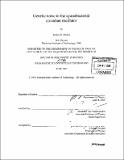Genetic noise in the cyanobacterial circadian oscillator
Author(s)
Chabot, Jeffrey R. (Jeffrey Raymond)
DownloadFull printable version (7.606Mb)
Other Contributors
Massachusetts Institute of Technology. Dept. of Physics.
Advisor
Alexander van Oudenaarden.
Terms of use
Metadata
Show full item recordAbstract
Clocks are generally considered as quintessential examples of accurate and precise devices. Biological clocks however, are continually subjected to intracellular and extracellular fluctuations that might reduce the fidelity of this periodic timer. One fundamental limitation that might set an upper bound on the fidelity is the stochastic nature of gene expression creating a noisy intracellular environment. Circadian rhythms, driven by oscillators which provide cells with an internal clock that controls the gene expression program, have been observed in a wide range of organisms from cyanobacteria to mammals. To explore the impact of stochastic expression fluctuations on the performance of the circadian clock, it is necessary to monitor single cells, since population experiments will average out these fluctuations. The cyanobacterium Synechococcus elongatus PCC7942 is an excellent candidate for this study since its core circadian oscillator is well explored. We therefore measured, in single cells, the expression fluctuations of a fluorescent reporter driven by the cyanobacterial circadian oscillator. Repeated microscopic imaging of individual cells and their progeny revealed a robust circadian rhythm, and experiments with cells lacking the proposed central clock proteins confirm the crucial role they play in Synechococcus. Experiments conducted by microscopy and flow cytometry establish that the majority of genetic noise in Synechococcus arises from fluctuations uncorrelated between multiple genes (and therefore does not originate with a global clock noise). (Cont.) We observed via flow cytometry measurements a significant variability in cell-to-cell gene expression which is most pronounced during periods of net protein synthesis. An analytic model reveals that this nonequilibrium effect arises when protein lifetimes are comparable to the circadian period and the mean number of proteins translated per mRNA transcript is large. Stochastic Monte Carlo simulations verify this interpretation by providing a window into genetic behavior on an individual cell level. Estimates of the genetic noise supplied by intrinsic (uncorrelated), extrinsic (correlated within individual cells), and "clock" (unexplained sources with a 24 hour period) noise are developed. A quantitative description of noisy oscillators will be necessary for ultimately understanding the fidelity of circadian timekeeping and might inspire the design of robust synthetic oscillators.
Description
Thesis (Ph. D.)--Massachusetts Institute of Technology, Dept. of Physics, June 2005. Includes bibliographical references (p. 155-161).
Date issued
2005Department
Massachusetts Institute of Technology. Department of PhysicsPublisher
Massachusetts Institute of Technology
Keywords
Physics.